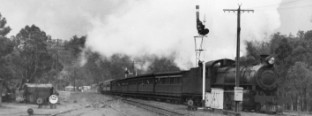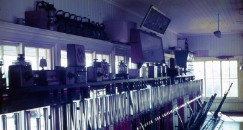The purpose of a Block Box was to reduce the 'headway' between following trains on busy double line sections. That is to say, to physically divide a normally longer section into shorter lengths so that trains could 'offered' and 'accepted' and moved quickly between the normal originating station and the normal destination station. This was achieved by the use of Block instruments. In the case of Cecil Street by the use of Sykes Lock and Block 'Through' instruments, of which there was one for each main line. The
Each instrument was located on the instrument shelf above the lever of the signal it controlled, which was only the Starting signal on each main line: No. 2 applying to the Up Main line (the top signal) was mounted on the same post as the Up Distant signal for West Leederville (the lower signal), whilst No. 8 was the Starting signal on the Down line.
In addition to the two Starting signals described above, the only other signals worked by the Cecil Street box were the Up and Down Distant signals. No. 1 lever worked the Up Distant, which was on a very tall signal post on the West Perth side of the Thomas Street (road over bridge), which also had the Down Distant Signal for West Perth mounted higher up on the opposite side of the post. This photo by the late R. L. Moss, shows the signal as it was in December 1961.
On the Down Main line, No. 9 lever worked the Down Distant signal, which was positioned underneath the West Leederville Starting Signal. In the photo above, the post closest to the camera are those signals - both showing 'Clear.' The white post to the left and further up the side of the embankment is a similarly arranged signal facing the opposite direction and was indeed signal No 2 (the top arm), with the Up Distant for West Leederville being the lower arm. The signal was placed in that location for ease of sighting by train crews in this curved cutting with restricted viewing due to the Thomas Street bridge.
This arrangement of signal arms was not uncommon at the time, as the distances between stations was short and the area of control by neccessity did overlap. In such an arrangement, and as an additional safety feature, the Distant signal could only be set to the 'Clear' indication if the Starting signal above it was also set to 'Clear'. In this way, the 'most restrictive' (i.e. the 'Stop' signal) always took precedence. This preventative measure was called 'slotting' and was usually achieved by a simple mechanical device fitted to the signal's counterweights on the signal post to co-ordinate both signals. One could imagine how confused a Driver might be if such a device was not used if they arrived at such a signal arrangement, to find the Distant signal showing 'Clear' when the Starting signal showed 'Stop'.
Whilst this arrangement worked well, all was, as is usual, not as it seems. The year 1922 saw a flurry of Royal Commissions on various matters in Western Australia, and the Royal Commission into the operation of the W. A. railways suggested sweeping reforms. Item 41 of the The WAGR Annual Report of 30th June 1922 foretold changes ahead. The report extolled the virtues of Automatic Electric Signalling. A loan of £31,000 was to be sought to install a scheme of Automatic Signalling from Midland Junction to East Perth and from Perth to Fremantle. Under this proposed scheme, the first section recommended to be converted was to be from Perth Box "B" to Subiaco and would enable the Department to cut out the West Leederville, Cecil Street and West Perth signal boxes, saving an estimated £2,213 per annum and increasing the carrying capacity of the line. One can only imagine today what this scheme would have looked like in reality, as a few years later, the WAGR did install automatic signalling between Bellevue to Mt. Helena via Swan View, and the signalling system then chosen was 3 position Upper Quadrant Signals.
On the 4th December, 1922 the General Appendix contained Instructions for Cecil Street Signal Box:
This Signal Box is switched in between certain hours (see current time table) and when required.
There is no Siding accommodation, and Cross-over roads are not provided.
Up and Down Home and Distant Signals are provided. The position of these signals when the Signal Box is closed will be “All Clear.”
The key of this Signal Box is in the possession of the Station-master at West Perth, from whom it must be obtained and to whom it must be returned when the box has been closed.
During 1944, the
Cecil Street Signal Box suffered the same fate as
Buckland Hill Signal Box some 22 years earlier, in so much as it was destroyed by fire. Unlike the
Buckland Hill Box, however, the
Cecil Street Signal Box was re-built and brought back into use again on the 9th of January 1945.
The final day for the box was the 24th March 1963 when the Sykes Lock & Block system of working was finally replaced with an Automatic Signalling system, first proposed 41 years earlier was installed. The new system however used colour-light signals of the 'searchlight' type rather than electrically motor-driven mechanical semaphone signal arms.
Today, all that remains of the Cecil Street Signal Box, is the stone foundations and a few brick steps from the track level, which once lead up to the timber staircase. These remains can be easily spotted from a passing 'Up' train or from the 'shared path' walkway between Thomas Street Bridge and West Leederville Station.
NOTE: This page is under development - please check back later, however, if you have any additional information on this signal cabin, it would be most welcome - please use the e-mail form provided.
Thanks to Neil Blinco for providing some great contemporary photos of the remaining foundations of this Signal Cabin.
Any additional information on this signal cabin would be most welcome - please use the e-mail form provided on this page.
Information researched and interpreted by Chris. J. E. French of SignallingWA
Photographs © by Chris. J. E. French and [] courtesy of RHWA Archives (image []) and Diagram of Signalling and Photograph © by W. A. G. R.
This page is copyright, and permission must be sought from SignallingWA before this page is used for any purpose other than personal education.
[Buy this page] or [View your SignallingWA ShoppingCart]


